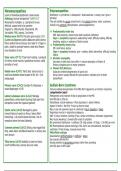Mononeuropathies Polyneuropathies
Lesion of individual peripheral/ cranial nerves Distribution = symmetrical + widespread + distal weakness + sensory loss (‘glove +
Aetiology trauma/ entrapment/ ‘WARDS PLC’ stocking’)
Mononeuritis multiplex: ≥ 2 peripheral nerves They are clarified by course (acute/chronic), by function (sensory, motor, autonomic,
affected, causes tend to be systemic mixed) or by pathology (demyelination, axonal degeneration)
Wegener’s, AIDs/Amyloid, Rheumatoid, DM,
Sarcoidosis, PAN, Leprosy, Carcinoma Predominantly motor loss
GBS, lead poisoning, charcot-marie-tooth syndrome, diphtheria
Median nerve (C6-T1) Precision grip muscles LOAF
Signs + symptoms progressive, weak/clumsy hands, difficulty walking, difficulty
(Lumbricals Opponens pollicis Abductor pollicis brevis
breathing, wasting + weakness of distal muscles
Flexor pollicis brevis) Sensory loss radial 3 ½ fingers + Predominantly sensory loss
palm, unable to pronate forearm, weak wrist flexion, DM, renal failure, leprosy
ulnar deviation of wrist Signs + symptoms Numbness, pins + needles, affects extremities, difficulty handling
objects
Ulnar nerve (C7-T1) ‘Claw hand’ wasting + paralysis Alcoholic neuropathy
of intrinsic hand muscles, hypothenar muscles, radial Secondary to both direct toxin effect + reduced absorption of Vitamin B
deviation of wrist Sensory symptoms prior to motor symptoms
Vitamin B12 deficiency
Radial nerve (C5-T1) ‘Wrist drop’ sensory loss to Subacute combined degeneration of spinal cord
small area between dorsal aspect of the 1st + 2nd Dorsal column usually affected first (joint position, vibration) prior to distal
metacarpals paraesthesia
Phrenic nerve (C3-C5) Consider if orthopnoea + Guillain-Barre Syndrome
raised diaphragm in CXR Immune-mediate demyelination of the PNS often triggered by an infection (classically
campylobacter jejuni)
Lateral cutaneous nerve (L2-L3) Meralgia Pathogenesis cross reaction of Abs w/ gangliosides in the PNS
paraesthesia, antero-lateral burning thigh pain from Anti-GM1 Abs in 25% pts
entrapment under the inguinal ligament Paraesthesia, muscle weakness flaccid paralysis + absent reflexes
Appear in hands + feet first move up (toes to nose)
Sciatic nerve (L4-S3) Damaged by pelvic May or may not experience pain commonly in back, shoulders + thighs
tumour/fracture to pelvis or femur, lesion affect Respiratory muscles respiratory inadequacy
hamstrings + all muscle below the knee / loss of ANS urinary retention, flushing of face, cardiac arrhythmias, orthostatic hypotension
Max muscle weakness 2-3 weeks after onset of symptoms
sensation below the knee bilaterally
Dx Symmetrical distribution + areflexia; CSF: High protein > 0.55g/L; < 10 WBC per mm3
Mx Plasmopheresis (plasma exchange), IVIG, Don’t use corticosteroids, mechanical
Common perineal (L4-S1) Sitting cross-legged foot
ventilation, IV Abx therapy, manually move limbs
drop, weak ankle, dorsiflexion/eversion + sensory loss Miller-fisher subtype
over dorsum Associated w/ ophthalmoplegia + areflexia + ataxia
Eye muscles affected first
Tibial nerve (L4-S3) Inability to stand on tiptoe, Usually presents as descending paralysis rather than ascending
invert foot/flex toes, sensory loss over soles Anti GQ1 seen in 90% cases




